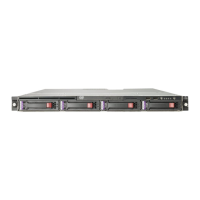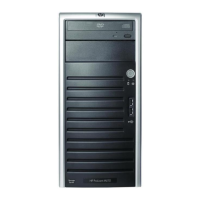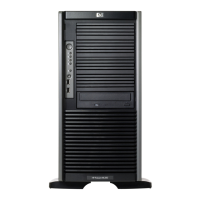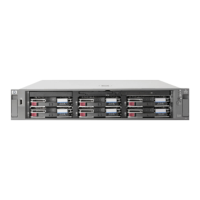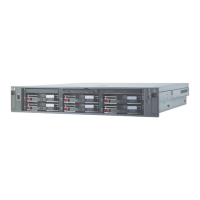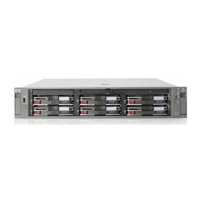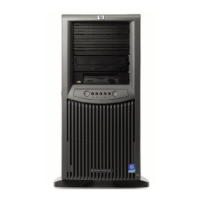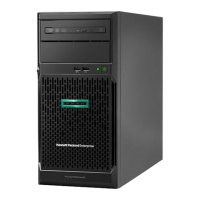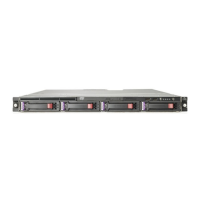
Do you have a question about the HP PROLIANT DL160 G5 and is the answer not in the manual?
| Chipset | Intel 5000P |
|---|---|
| Hard Drives | SAS or SATA |
| Operating System Support | Microsoft Windows Server, Red Hat Enterprise Linux, SUSE Linux Enterprise Server, VMware |
| Form Factor | 1U Rack |
| Processor | Intel Xeon 5400 series |
| Memory | Up to 32GB |
| Drive Bays | Four (4) 3.5-inch LFF SAS/SATA hot-plug drive bays or Eight (8) 2.5-inch SFF SAS/SATA hot-plug drive bays |
| RAID Support | HP Smart Array E200 |
| Network Interface | Embedded NC373i Multifunction Gigabit Network Adapter |
| Expansion Slots | 1 PCIe x8 |
Details the target audience for this guide, focusing on technical professionals.
Lists supplementary documents and websites for additional information.
Explains formatting conventions and symbols used throughout the document.
Provides safety information regarding rack stability for personnel and equipment.
Information on how to obtain technical support from HP, including required details.
Details HP's customer self-repair program for replacing product parts.
Information on HP StorageWorks product warranties and related websites.
Information on registering products and receiving updates via HP's subscription service.
Lists relevant HP websites for additional product information and resources.
Instructions for providing comments and suggestions regarding the product documentation.
Provides an overview of the HP ProLiant Storage Server operating systems and features.
Guidance on making decisions before installing the HP ProLiant Storage Server.
Describes how to select a network access method based on network configuration.
Details information needed for planning the storage server's network configuration.
A checklist to ensure all configuration tasks for the storage server are completed.
Instructions for the physical installation of the HP ProLiant Storage Server.
Guide on how to find and record the storage server's serial number.
Instructions to verify all components are present in the server's kit.
Steps for powering on the storage server and the initial installation process.
Details about the preconfigured storage settings and operating system images.
Explains the physical layout of logical disks on the server based on RAID configurations.
Describes the default BIOS boot sequence for the storage server.
Guide on how to access the server's management console.
Instructions for accessing the management console directly via monitor, mouse, and keyboard.
Steps to access the management console using a web browser over the network.
Guide for remotely accessing and administering the server using Remote Desktop.
Explains the options for disconnecting and logging off Remote Desktop sessions.
Information about the Telnet Server utility and how to enable it.
Overview of remote management functionalities using HP ProLiant Lights-Out technologies.
Instructions for remotely managing servers using the Lights-Out 100 interface.
Guide for managing servers remotely using the Integrated Lights-Out 2 (iLO 2) interface.
Steps for configuring the server's network settings using the Rapid Startup Wizard.
Additional setup tasks after initial configuration, such as updates and user management.
Illustrations and descriptions of the front and rear panel components of the ML110 G5.
Illustrations and descriptions of the front and rear panel components of the DL160 G5.
Illustrations and descriptions of the front and rear panel components of the DL185 G5.
Illustrations and descriptions of the front and rear panel components of the DL380 G5.
Illustrations and descriptions of the front and rear panel components of the DL585 G2.
Explains the status indicators for SAS and SATA hot-plug hard drives.
Details combinations of system LEDs and internal health LEDs for status indication.
Divides storage into four major divisions: physical, logical, file system, and file sharing elements.
Illustrates a typical storage management process with various storage elements.
Discusses the lowest level of storage management at the physical drive level.
Explains how physical drives are combined into logical units called arrays.
Discusses protecting against data loss using fault tolerance and RAID configurations.
Explains the use of online spares for further protection against data loss.
Describes components that translate physical storage elements into file system elements.
Defines logical drives (LUNs) as components translating physical storage to file system elements.
Details primary and extended partitions and their limitations on LUNs.
Discusses volume growth limits, RAID levels, and volume types like spanning or mirrored.
Explains file system elements composed of folders and subfolders for data organization.
Describes supported file sharing protocols like DFS, NFS, FTP, HTTP, and SMB.
Introduces Volume Shadow Copy Service (VSS) for creating point-in-time volume snapshots.
Covers determining drive letters, mount points, and formatting for storage elements.
Discusses cluster-aware file sharing protocols and their setup in a cluster.
Explains network adapter teaming for increasing server network availability and performance.
Introduces management tools like HP Systems Insight Manager and Management Agents.
Identifies file services in Windows Storage Server 2003 R2, including Storage Manager.
Explains Single Instance Storage (SIS) for recovering disk space by reducing redundant data.
Details File Server Resource Manager (FSRM) for managing server data quantity and type.
Describes Windows SharePoint Services for collaboration and communication.
Overview of the HP Storage Server Management Console for managing files and print services.
Information on managing storage server in a SAN environment.
Discusses configuring storage by creating arrays, logical disks, and volumes.
Lists preinstalled storage management utilities, including the HP Array Configuration Utility.
Details the Disk Management tool for managing hard disks, volumes, and partitions.
Provides best practices for managing disks and volumes on the storage server.
Explains how to schedule defragmentation to improve file system performance.
Describes how disk quotas track and control disk space usage in volumes.
Explains the process of adding physical disks to an array or new storage space to a logical drive.
Details how to expand storage by adding physical disks to an array.
Guide on growing logical drive storage space using Windows Storage Utilities.
Instructions for extending dynamic volumes using the Disk Management snap-in.
Details expanding storage for EVA arrays using the Command View EVA utility.
Explains how to expand arrays and logical drives using the Array Configuration Utility.
Introduces volume shadow copies for creating point-in-time snapshots of volumes.
Considerations for planning shadow copy implementation, including volume and disk space.
Guidance on identifying suitable volumes for taking shadow copies, typically user files.
Factors to consider when determining disk space for storing shadow copies.
Discusses options for storing shadow copies on separate disks for better performance.
Explains how to determine the frequency of shadow copy creation.
Discusses potential loss of shadow copies during disk defragmentation.
Explains mounted drives and their inclusion/exclusion in shadow copies.
Instructions on managing shadow copies using the vssadmin tool and the server desktop.
Details the location and management of the shadow copy cache file.
Steps to enable shadow copies on a volume and create initial copies.
Procedure to view a list of shadow copies for a volume.
Explains how shadow copy schedules control the frequency of copy creation.
Details how to view shadow copy properties like copy count and maximum size.
Instructions on how to redirect shadow copies to a different volume.
Explains the process and consequences of disabling shadow copies.
Steps to manage shadow copies directly from the storage server's desktop.
Discusses accessing shadow copies over the network via supported clients and protocols.
Details how Windows users access previous file versions stored on SMB shares.
Explains how UNIX users access previous file versions stored on NFS shares.
Covers common situations requiring file or folder recovery using shadow copies.
Step-by-step guide to recovering deleted files or folders using shadow copies.
Procedure for recovering overwritten or corrupted files using shadow copies.
Steps to recover entire folders, including subfolders, using shadow copies.
Discusses how shadow copies relate to file system backups and open files.
Explains transporting data via shadow copies over a Storage Area Network (SAN).
Discusses file sharing protocols and procedures for setting up and managing file shares.
Details managing folders using the HP Storage Server Management Console.
Explains managing file-level security, including permissions, ownership, and auditing.
Methods for setting up and managing shares using Explorer, command line, or console.
Planning content, size, and distribution of shares to improve performance and manageability.
Explains Access Control Lists (ACLs) that dictate user and group access to shares.
Discusses integrating local file system security with Windows domain environments.
Differentiates between administrative (hidden) and standard CIFS shares.
Steps for managing shares, including creating, deleting, and modifying properties.
Introduces File Server Resource Manager (FSRM) for managing server data.
Details how to create and manage quotas to limit disk space usage.
Explains file screening for controlling file types and notifying users of blocked files.
Describes how to schedule and generate storage reports for disk usage analysis.
Information on Windows Support Tools and Resource Kit Tools for disk management.
Provides additional references and information for file services.
Details HP StorageWorks Library and Tape Tools (L&TT) functionality.
Recommendations for securing the server by installing appropriate antivirus software.
Guidance on hardening file servers by referencing Microsoft Windows Server 2003 Security Guide.
Lists websites with detailed information for using print services with Windows Server 2003.
Describes the Microsoft Print Management Console for managing print tasks.
Highlights new and improved HP print server features.
Details HP Web Jetadmin for remotely installing and managing network peripherals.
Explains the HP Install Network Printer Wizard for simplifying network printer installation.
Describes HP Download Manager for upgrading HP Jetdirect print server firmware.
Details the Microsoft Print Migrator utility for printer configuration backup and migration.
Information on updated print drivers for HP network printers supplied on the Service Release DVD.
Online resources for planning, setting up, managing, and troubleshooting print servers.
Instructions for installing the HP Web Jetadmin software.
Discusses web-based printer management and Internet printing features.
A checklist of items to consider before configuring the print server.
Steps for creating print queues using Windows Printer and Faxes or HP Install Network Printer Wizard.
Regular tasks required to support print services, including performance monitoring.
Information on obtaining and updating print drivers for HP network printers.
Explains the difference between user-mode and kernel-mode drivers for printers.
Details how to enable kernel-mode driver installation, which is blocked by default.
Information on upgrading HP Jetdirect print server firmware using the DLM utility.
Factors influencing print server configuration capacity and sizing.
Recommendations for backing up print server configuration and using Print Migrator.
Practical advice for managing print devices and print servers effectively.
Guidance on troubleshooting general and common print-related problems.
Links to resources for more information on print services with Windows Server 2003.
Lists new features of MSNFS, including updated administration and enhanced performance.
Explains how Identity Management for UNIX integrates Windows and UNIX environments.
Describes use cases for MSNFS, allowing UNIX to access Windows resources and vice versa.
Details the three main components of MSNFS: Username Mapping Server, Server for NFS, Client for NFS.
Explains how Windows computers can access files on UNIX-based NFS servers.
Instructions for accessing and administering Microsoft Services for Network File System.
Describes how Windows Server 2003 can act as an NFS server for both Windows and UNIX clients.
Compares authentication methods for Server for NFS with Active Directory domain controllers.
Steps for installing the NFS Authentication DLL on Windows 2000 domain controllers.
Information on administering Server for NFS, including topics like shares and performance.
How Windows clients access NFS resources using UNIX UID/GID information or Active Directory.
Details how to manage access to User Name Mapping using the .maphosts file.
Steps to enable anonymous access to an NFS share for users without mapped accounts.
Provides best practices for running Server for NFS, focusing on security and configuration.
Explains User Name Mapping for centralized user mapping between Windows and UNIX accounts.
Information on administering User Name Mapping, including managing maps and groups.
Best practices for implementing and managing User Name Mapping effectively.
Resources for troubleshooting common issues with Microsoft Services for NFS.
Lists Windows command-line administration tools for MSNFS.
Sources for optimizing performance for Microsoft Services for NFS.
Information on UNIX clients sending print jobs to the storage server's line printer daemon.
Details File and Print Services for NetWare (FPNW) for integrating storage servers with NetWare.
Steps for installing FPNW to integrate with existing Novell servers.
How to manage FPNW resources and shared volumes using Server Manager.
Process for creating and managing NetWare users as local users on the storage server.
Instructions for adding local NetWare users through the Management Console.
Steps to enable local NetWare user accounts and configure their properties.
Details on creating and managing NCP volumes (shares) using Server Manager.
Step-by-step guide to creating a new NCP file share.
Instructions on how to modify properties of an existing NCP file share.
Explains how print servers appear to NetWare clients and process print jobs.
Reference to installing Print Services for NetWare.
Discusses Point-and-Print behavior from Novell clients to Windows Server 2003.
Links to resources for more information on File and Print Services for NetWare.
Details AppleTalk network integration for sharing files and printers with Macintosh clients.
Steps to install the AppleTalk protocol for network connections.
Instructions for installing File Services for Macintosh.
Guidance on completing setup for AppleTalk protocol properties and shares.
Explains how Macintosh clients can send print jobs to a print server.
Discusses Point-and-Print behavior from Macintosh clients to Windows Server 2003.
Describes remote administration from non-Microsoft computers using the browser applet.
Details the Microsoft iSCSI Software Target snap-in for managing iSCSI targets and virtual disks.
Explains iSCSI virtual disks (VHD files) offering flexible and efficient storage.
Discusses scheduling and creating snapshots of iSCSI virtual disks for backup and recovery.
Introduces wizards for creating iSCSI targets, virtual disks, and snapshots.
Step-by-step guide to creating an iSCSI Target using the Create iSCSI Target Wizard.
Instructions for creating an iSCSI Virtual Disk using the Create Virtual Disk Wizard.
Guide on how to import a virtual disk using the Import Virtual Disk Wizard.
Steps to extend a virtual disk using the Extend Virtual Disk Wizard.
Instructions for scheduling snapshots using the Schedule Snapshot Wizard.
Discusses using the Microsoft iSCSI Software Target VDS Hardware Provider for advanced management.
Explains using iSCSI Software Target to share highly available storage in a cluster.
Describes the basic concept of a cluster and its availability features.
Defines key terms and components related to cluster administration.
Defines nodes as the individual servers that make up a cluster.
Explains cluster resources, their characteristics, and types.
Describes cluster groups as the basic unit of failover between nodes.
Defines virtual servers as cluster groups with IP address and network name resources.
Explains the process of failover and failback for cluster groups and resources.
Details the Quorum disk's role in coordinating cluster state and maintaining data integrity.
Illustrates a typical cluster configuration and the relationship between elements.
Describes the sequence of events involved in cluster resource creation.
Explains the hierarchy of cluster resource components like physical disks and file shares.
Outlines requirements for planning a cluster, including storage, network, and protocol planning.
Discusses designating a basic disk as the Quorum disk and presenting additional disks.
Details network requirements for clusters, including domain, IP addresses, and names.
Discusses which file sharing protocols support clustering and failover.
Steps to prepare for cluster installation, confirming specifications.
Confirms necessary specifications and software components before cluster installation.
Recommends dual data paths for high availability and discusses multipathing software.
Explains the process of enabling cluster-aware NFS, including uninstalling NFS first.
Checklists to assist in preparing for cluster server installation.
Lists required network elements for a cluster, including names and IP addresses.
Details requirements for shared disks, including access, configuration, and formatting.
Describes the cluster installation process, including node reboots and data protection.
Verifies correct network connections, including private and public network adapters.
Best practices for configuring the private network adapter, including static IP addresses.
Recommendations for configuring the public network adapter, preferring static IP addresses.
Suggests renaming network connection icons for clarity and role identification.
How to verify name resolution by pinging nodes using machine names.
Ensures all cluster nodes are members of the same domain and access domain controllers.
Describes the requirement for a unique domain user account for Cluster service administration.
HP recommendations for the Quorum disk, including size, configuration, and drive letter.
Using Disk Management to configure additional shared disk resources.
Steps to verify functionality of shared disk resources by writing files.
Introduction to Cluster Administrator for managing, monitoring, and modifying clusters.
Information about the Cluster Administrator tool for managing cluster groups and resources.
Possibilities for administering clusters remotely using Cluster Administrator copies.
Location of Cluster Administrator within the HP Storage Server Management Console.
Process of creating a cluster, including hardware/software verification and issue identification.
Steps for adding new nodes to an existing cluster, managing disk access.
Discusses geographically dispersed clusters for added fault tolerance.
Overview and planning issues for cluster groups, resources, and clustered file shares.
Describes the default cluster group created upon cluster creation.
Explains node-based cluster groups for facilitating group and resource administration.
Discusses creating separate cluster groups for virtual servers to balance processing load.
Addresses cluster-aware protocols and planning for high availability of file shares.
Steps for resource planning in a cluster, including creating groups and file shares.
How to manage share permissions using Cluster Administrator for migration.
Suggestions for managing NFS cluster-specific issues like user mappings and domain accounts.
Discusses file sharing protocols that are not cluster-aware and their service interruption.
Process for adding new storage to a cluster via selective storage presentation or SAN zoning.
Steps for creating physical disk resources within a cluster group.
References online help topics for creating cluster-managed file shares.
Guide to creating NFS share resources, referencing MSNFS administration.
Recommendations for placing shadow copy cache files on separate disks in a cluster.
Procedures for extending a LUN on a storage array within a cluster.
Topics covered in MSNFS online help for server cluster administration.
Best practices for running Server for NFS in a clustered environment.
How Windows Server 2003 Cluster service increases availability of critical print servers.
Steps for creating a dedicated group and resources for a cluster printer spooler.
Procedures for advanced cluster administration tasks.
Details on how resources fail over to other nodes and the failback process.
Procedure and cautions for restarting a single cluster node.
Procedure and cautions for shutting down a single cluster node.
Steps and cautions for safely powering down the storage server cluster.
Critical steps and cautions for powering up the storage server cluster.
Websites providing detailed information for cluster services in Windows Server 2003.
Guide to troubleshooting storage server problems using HP Support & Drivers website.
Details WEBES tool suite for preventing or reducing system downtime.
Information on HP's specific documentation for maintaining and servicing storage servers.
References maintenance and service guides for HP ProLiant Storage Servers.
Information on obtaining regular maintenance updates from the HP ProLiant Storage Server Service Release DVD.
Details system updates for hardware, firmware, drivers, and software bundled on the Service Release DVD.
Explains firmware and the importance of updating it for server performance.
Explains the purpose of the Certificate of Authenticity (COA) label for license validation.
Describes the System Recovery DVD for installing images or recovering from failures.
Steps to restore the server to its factory default image using the recovery DVD.
Information on the DON'T ERASE partition for restoration processes.
Guide on managing drive letters after restoring the system.
Methods for configuring an Internet connection for the storage server.
FCC rules on radio frequency (RF) emission limits and device classification (Class A/B).
Compliance information for Class A digital devices operated in commercial environments.
Compliance information for Class B digital devices in residential environments.
FCC compliance statement for products with an FCC logo in the United States.
FCC notification regarding unauthorized modifications to the device.
Requirement for using shielded cables with metallic RFI/EMI connector hoods.
Information on laser compliance for optical storage devices and transceivers.
Statements and regulations from various international bodies and countries.
Canadian compliance information for Class A and Class B digital apparatus.
CE marking compliance with EMC, Low Voltage, and R&TTE Directives.
BSMI notice regarding product compliance.
Japanese notice regarding product disposal and recycling.
Korean notice for Class A and Class B equipment compliance.
WARNING regarding internal battery pack, fire risk, and handling precautions.
Taiwan EPA requirements for battery recycling marks.
Requirements for power cord sets, including country approval and specifications.
Japanese notice regarding the provided power cord.
Precautions to prevent damage from static electricity discharge to system components.
Specific precautions for preventing electrostatic damage during handling.
Methods for grounding when handling or installing electrostatic-sensitive parts.
Information regarding the disposal of waste electrical and electronic equipment.
Notice for Czechoslovakian users regarding disposal of used equipment.
Danish notice regarding disposal of household waste in the European Union.
Dutch notice on disposal of used equipment by private users in the EU.
English notice for disposal of waste equipment by users in private households in the EU.
Estonian notice regarding disposal of equipment by private households in the EU.
Finnish notice on disposal of household equipment in the European Union.
French notice on disposal of household equipment in the European Union.
German notice on disposal of used equipment from private households in the EU.
Greek notice regarding disposal of household waste in the European Union.
Hungarian notice on disposal of household equipment in the European Union.
Italian notice on disposal of equipment by private users in the EU.
Latvian notice on disposal of used equipment by private users in the EU.
Lithuanian notice regarding disposal of household waste in the European Union.
Polish notice on disposal of used equipment by private users in the EU.
Portuguese notice on disposal of electrical and electronic waste in the EU.
Slovakian notice regarding disposal of used equipment by private households in the EU.
Slovenian notice on disposal of used equipment by private users in the EU.
Spanish notice on disposal of electrical and electronic equipment by users in the EU.
Swedish notice on disposal of waste products by users in private households in the EU.
